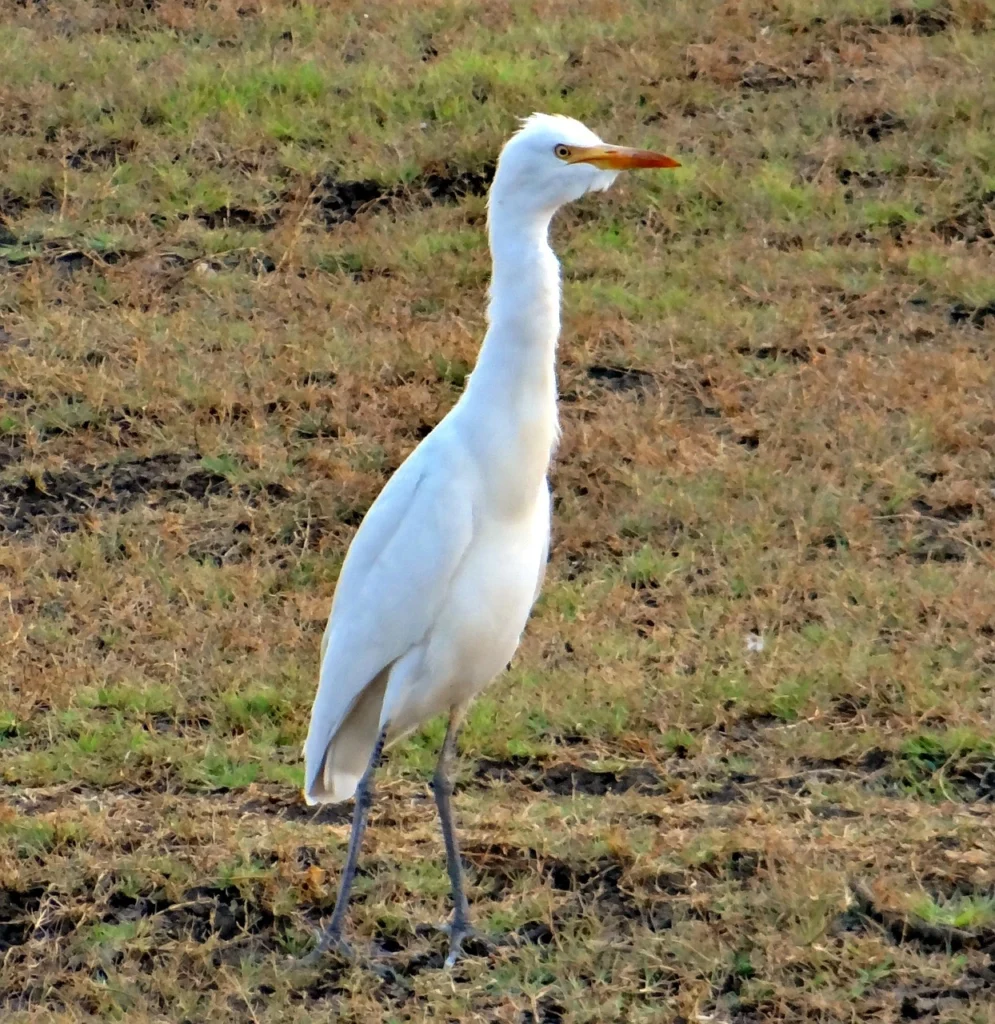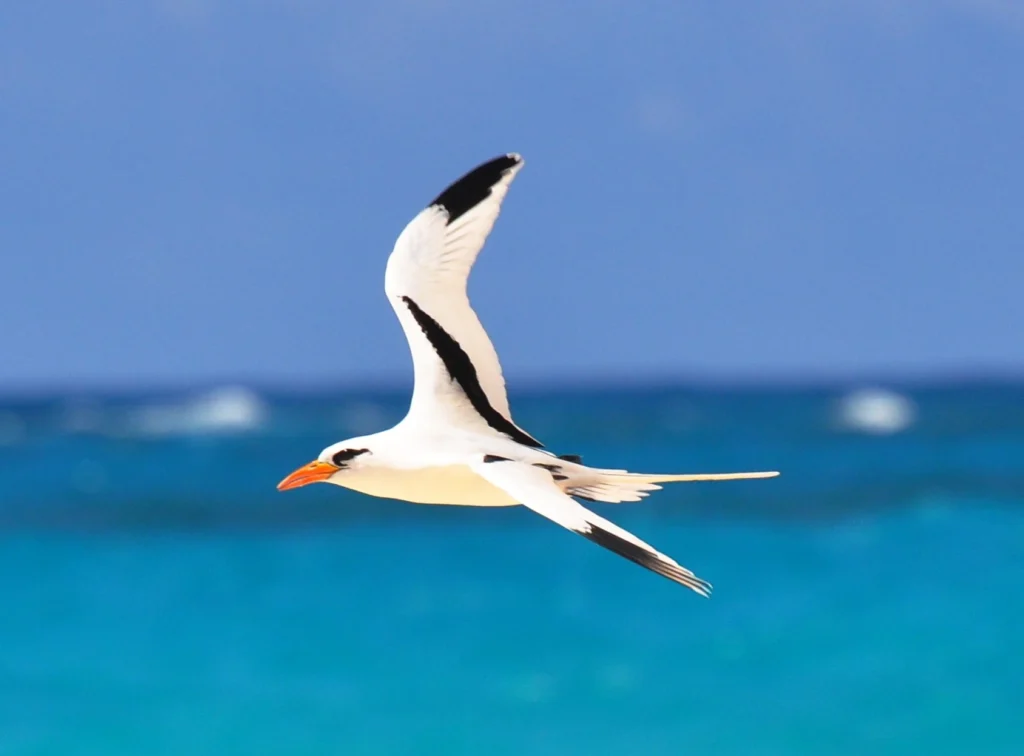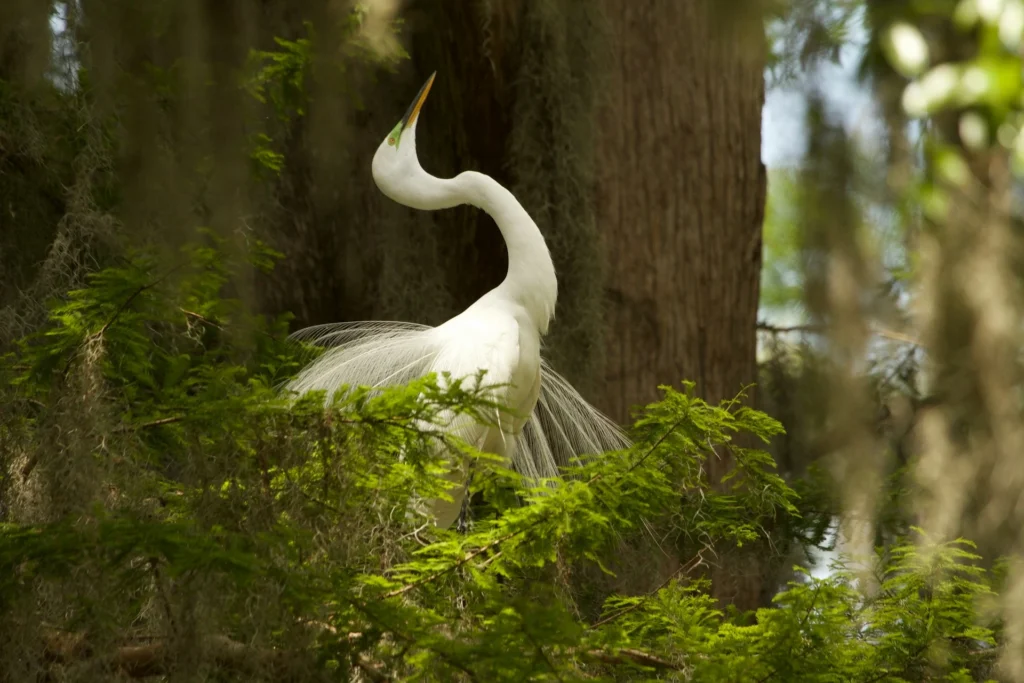Florida, with its sun-soaked beaches and lush wetlands, is a paradise for bird watchers. Among the myriad of avian wonders, white birds with long beaks stand out, gracing the skies and waters with their elegance and beauty. In this article, we delve into the fascinating world of these magnificent creatures.
From their unique habitats to their diverse diets, and five intriguing fun facts about each, get ready to explore the enchanting lives of 12 white birds in Florida. With stunning pictures to accompany each fact, prepare to be captivated by the splendor of these feathered wonders.
White Birds in Florida
1. Great Egret

The Great Egret is a large, stunning bird that you can spot all over the world! Known by many names like the common egret, large egret, great white egret, or great white heron, this elegant creature has four subspecies found in Asia, Africa, the Americas, and southern Europe.
- Habitat: Great Egrets love hanging out in freshwater and saltwater marshes, streams, ponds, lakes, and mudflats. In Connecticut, they prefer nesting on uninhabited offshore islands in Long Island Sound.
- Diet: These birds are opportunistic foragers, which means they’ll eat what they can find. Their diet mainly includes fish, but they also snack on crustaceans, amphibians, and small mammals.
Fun Facts:
- The wings of the Great Egret are longer and broader compared to most other white herons, making them beautiful to watch in flight.
- When flying, they hold their neck in a more open S-shape, unlike other white herons.
- Their call is a loud, low-pitched, hoarse croak.
- Males and females look quite similar, but the males are just a bit bigger.
Also read: Types of Yellow Birds in Michigan
2. Ibis

The White Ibis is a striking bird with its reddish-pink legs and long, curved bill. These birds are social butterflies, often seen moving around in large flocks. They love to hang out in shallow wetlands or flooded fields, where they spend their time walking through the water in search of food. Unlike larger herons that prefer to stalk their prey, White Ibises are always on the move, making them easy to spot.
- Habitat: The White Ibis thrives in a variety of coastal environments. You can find them in freshwater, saltwater, and brackish marshes, rice fields, mudflats, mangrove swamps, and lagoons.
- Diet: White Ibises typically feast on invertebrates such as freshwater crayfish and crickets. However, due to the decline in the quality of their natural habitats and their growing population, many have adapted to urban areas, supplementing their diet with scraps from landfill sites, bins, and litter.
Fun Facts:
- The name “Ibis” comes from Latin and Ancient Greek, reflecting the bird’s long history and cultural significance.
- White Ibises are known for their long, slender legs, which make them excellent waders in shallow waters.
- These birds have a unique foraging style, often seen probing the mud with their curved bills to catch their prey.
- They are highly social and prefer to travel in flocks, making them easy to spot in large groups.
- Despite their graceful appearance, White Ibises are quite adaptable and have learned to thrive in urban environments, often seen scavenging in cities and towns.

3. Herons

Herons are elegant, long-legged birds often seen standing still in the water, waiting patiently to catch their prey. They are a common sight in Florida and are known for their graceful movements and striking appearance.
- Habitat:
Herons love wetlands! You can find them in marshes, swamps, rivers, lakes, and coastal areas. They are quite adaptable and can thrive in both freshwater and saltwater environments.
- Diet:
Herons primarily eat fish, but they also enjoy a variety of other foods like amphibians, insects, and small mammals. They are skilled hunters, using their sharp beaks to catch their prey with precision.
Fun Facts:
- Herons can stand still for long periods, waiting for the perfect moment to strike at their prey.
- They have a unique S-shaped neck, which helps them quickly extend their beak to catch fish.
- During the breeding season, herons develop beautiful plumage to attract mates.
- Herons nest in colonies called rookeries, often high up in trees to protect their young.
- Despite their large size, herons are excellent fliers and can travel long distances to find food.
4. Snowy Egret

The Snowy Egret is a stunning white bird with striking black legs and bright yellow feet, often called “golden slippers.” These small egrets are known for their graceful appearance and lively hunting techniques.
- Habitat:
Snowy Egrets are commonly found in wetlands, marshes, and along coastal shorelines. They love shallow waters where they can easily hunt for food.
- Diet:
Snowy Egrets primarily feed on fish and crustaceans but also enjoy insects and small amphibians. They use their yellow feet to stir up the water and flush out prey.
Fun Facts:
- Snowy Egrets were once hunted for their beautiful feathers, which were used in fashion.
- They are very active hunters, often seen running through the water to catch their prey.
- Their yellow feet act as lures, attracting fish and other prey.
- Snowy Egrets are social birds, often seen in groups with other wading birds.
- They have a loud, raspy call that they use to communicate with each other.
5. American White Pelican

The American White Pelican is a large, impressive bird with a striking orange bill and a massive wingspan. They are known for their cooperative hunting techniques and graceful flight.
- Habitat:
You can find American White Pelicans in lakes, rivers, and coastal lagoons. They prefer calm waters where they can easily catch fish.
- Diet:
These pelicans primarily eat fish, scooping them up with their large bills. They are also known to eat amphibians and crustaceans when fish are scarce.
Fun Facts
- American White Pelicans are excellent team players, often working together to herd fish into shallow waters for easy catching.
- They have a wingspan of up to 9 feet, making them one of the largest birds in North America.
- Unlike brown pelicans, they do not dive for fish but catch their prey while swimming.
- During the breeding season, the males develop a distinctive bump on their bills.
- These pelicans migrate long distances, traveling from their breeding grounds in the interior of North America to coastal wintering sites.
6. Wood stork

The Wood Stork is a large, striking wading bird known for its distinctive appearance and fascinating behaviors. Despite its name, it’s not an ibis! This bird is the only member of its family that breeds in North America, making it a unique sight in Florida.
- Habitat:
Wood Storks love subtropical and tropical environments. You can find them in wetlands, swamps, and marshes across Florida and the Caribbean. They prefer areas with shallow water where they can easily forage for food.
- Diet:
Wood Storks primarily eat fish, but they also enjoy a variety of other foods like frogs, insects, and small crustaceans. They are expert foragers, often seen wading through shallow waters with their beaks open, waiting to snap up any unsuspecting prey that swims by.
Fun Facts:
- Wood Storks have a unique foraging technique called “tactile feeding,” where they keep their beaks open in the water and snap them shut when they feel something touch them.
- They are social birds and often nest in large colonies, which can include hundreds of pairs.
- During the breeding season, Wood Storks build large, stick nests high in trees, often over water to protect their young from predators.
- They are known for their bald heads, which help keep them clean while feeding in muddy waters.
- Wood Storks can travel great distances to find food, sometimes flying over 50 miles a day to their feeding grounds.
7. Bubulcus

The Cattle Egret, also known by its scientific name Bubulcus ibis, is a small, stocky heron with a short neck. These charming birds are pure white, except during the breeding season when they sport beautiful orange buff plumes on their crown, back, and foredeck. Cattle Egrets are found in the tropics, subtropics, and warm-temperate zones across the globe.
- Habitat:
Cattle Egrets are unique among herons because they prefer drier, open habitats. You can find them in seasonally flooded grasslands, pastures, farmlands, wetlands, and rice paddies. They are often seen accompanying cattle or other large mammals, making them a common sight in agricultural areas.
- Diet:
These adaptable birds primarily feed on insects and small vertebrates, such as frogs and lizards. They take advantage of large mammals that disturb insects and other prey as they move through fields, making it easy for the egrets to catch their meals.
Fun Facts:
- The name “Cattle Egret” comes from their habit of following cattle and other large animals to catch insects that are stirred up.
- During the breeding season, Cattle Egrets develop stunning orange buff plumes, adding a splash of color to their otherwise white feathers.
- Originally native to Africa and Asia, Cattle Egrets have successfully spread to every continent except Antarctica, thanks to their adaptability.
- While they primarily eat insects, Cattle Egrets are opportunistic feeders and will also eat small birds, reptiles, and even small mammals when available.
- Cattle Egrets build their nests in colonies, often with other wading birds. They use sticks and other plant materials to create sturdy nests in trees or shrubs.
8. Stork

Storks are large, long-legged, and long-necked wading birds with long, stout bills. These majestic birds belong to the family Ciconiidae and are well-known for their graceful presence and impressive size. They are often seen wading through wetlands and are a delight to spot in Florida’s natural habitats.
- Habitat:
Storks breed in fresh and brackish forested wetlands. They forage in wetlands, swamps, ponds, and marshes with shallow water depths of around 4–12 inches. They prefer open wetlands for foraging and roost in trees along the water’s edge.
- Diet:
Storks are carnivorous and have a varied diet. They eat small mammals, large insects, amphibians, snakes, lizards, earthworms, fish, eggs, and hatchlings of ground-nesting birds, mollusks, and crustaceans. Their diet can change depending on the season and availability of food.
Fun Facts:
- According to European folklore, the white stork is famously known for bringing babies to new parents, a legend popularized by Hans Christian Andersen’s story “The Storks.”
- Storks have an incredibly diverse diet and will eat almost anything they can catch, from insects and fish to small mammals and reptiles.
- Storks are quite tall, usually standing between 2 to 5 feet (0.6 to 1.5 meters) tall. The largest stork, the marabou, can be found in Africa.
- The white stork is known for nesting on rooftops and chimneys in towns, making them a common sight in some urban areas.
- During droughts, storks primarily eat insects and mice, while in wetter years, they feast on aquatic animals, showcasing their adaptability.
9. Willet

The Willet is a large shorebird often seen along Florida’s coastlines, estuaries, and marshes. Distinguished by its long, straight beak and striking white wing patches visible in flight, the Willet is a captivating sight. These birds typically forage in shallow waters, using their beaks to probe the sand and mud for small invertebrates. They are known for their distinctive, piercing calls, often heard before the birds are seen. During the breeding season, Willets migrate to the northern interior regions of North America but return to Florida’s shores in the winter.
- Habitat:
Willets are typically found in coastal habitats such as beaches, mudflats, and marshes. They are often seen foraging along the shoreline and in shallow waters.
- Diet:
Willets have a varied diet that includes insects, crustaceans, small fish, and mollusks. They forage by probing the sand and mud with their long bills.
Fun Facts:
- The most distinguishing feature of Willets is the bold white wing patches that become visible when they fly.
- There are two subspecies of Willets, one that breeds inland and another that breeds along the coast.
- Willets are known for their loud, piercing calls, especially during the breeding season.
- Coastal Willets migrate to South America for the winter, while inland Willets stay in North America but move to coastal areas.
- Their nests are well-camouflaged among grasses, making them difficult to spot.
10. Royal Tern

The Royal Tern is a striking bird with a sleek, white body, a black cap on its head, and a long, orange beak. These elegant birds are commonly found along Florida’s sandy beaches and coastal waters, often seen diving gracefully into the water to catch fish. Their social nature leads them to gather in large colonies, where their loud, raucous calls are a common sound. Royal Terns are masterful fliers, capable of impressive aerial acrobatics.
Habitat:
Royal Terns prefer coastal habitats such as sandy beaches, islands, and estuaries. They are commonly seen near the shore, either resting or foraging.
Diet:
Royal Terns primarily eat fish, which they catch by diving into the water from flight. They also eat crustaceans and other small marine creatures.
Fun Facts:
- Royal Terns are excellent divers, plunging into the water to catch fish with their sharp bills.
- Their bright orange bills are not only striking but also a key identifying feature.
- These birds nest in large colonies, often alongside other seabirds, providing safety in numbers.
- Males perform elaborate courtship displays, offering fish to females as a gift.
- Royal Terns migrate along the coasts of North and South America, following the warm weather.
11. White-tailed Tropicbird

kansasphoto, CC BY 2.0, via Wikimedia Commons
The White-Tailed Tropicbird is a rare and exotic visitor to Florida, known for its graceful flight and striking appearance. With a predominantly white body, long tail feathers, and a distinctive black eye mask, this bird is a marvel to behold. These birds are pelagic, spending most of their lives over the open ocean and only coming to land to breed. They are known for their elegant, soaring flight patterns and their ability to navigate vast distances across the ocean.
Habitat:
White-tailed Tropicbirds are typically found in tropical and subtropical oceans. They nest on remote islands and cliffs but can sometimes be seen near the coast.
Diet:
Their diet consists mainly of fish and squid, which they catch by diving into the water from flight.
Fun Facts:
- The long, white tail feathers are a distinctive feature, making them easy to identify.
- These birds are skilled divers, plunging from heights to catch fish and squid.
- Unlike many seabirds, White-tailed Tropicbirds often nest alone or in small groups.
- They are known for their graceful flight, often gliding effortlessly over the ocean.
- Spotting a White-tailed Tropicbird in Florida is a special treat due to its rarity in the region.
12. Mute Swan

The Mute Swan is an iconic and graceful bird, often associated with beauty and elegance. These large, white birds are easily recognizable by their long necks, orange bills with black basal knobs, and their habit of holding their wings slightly raised in a display of grandeur. Mute Swans are commonly found in Florida’s lakes, ponds, and slow-moving rivers. Despite their name, they are not entirely mute but are less vocal than other swan species.
Habitat:
Mute Swans are often found in ponds, lakes, and slow-moving rivers. They are also common in park settings and urban water bodies.
Diet:
Mute Swans primarily feed on aquatic vegetation, but they also eat small fish, insects, and other invertebrates.
Fun Facts:
- Mute Swans are known for their graceful movements on water, often gliding smoothly across the surface.
- They often hold their necks in an elegant S-shape, a classic pose associated with swans.
- Mute Swans are highly protective of their nests and young, often chasing away potential threats.
- These swans can live for many years, with some reaching up to 20 years old in the wild.
- Despite their name, Mute Swans do make sounds, including hissing and grunting, especially when threatened.
So these were the top 12 White Birds you can find in Florida!

Welcome to World Birds Life, where the wonder of birds takes center stage. My name is Lexi, and I’m passionate about helping you discover the beauty and joy that birds bring into our lives.







